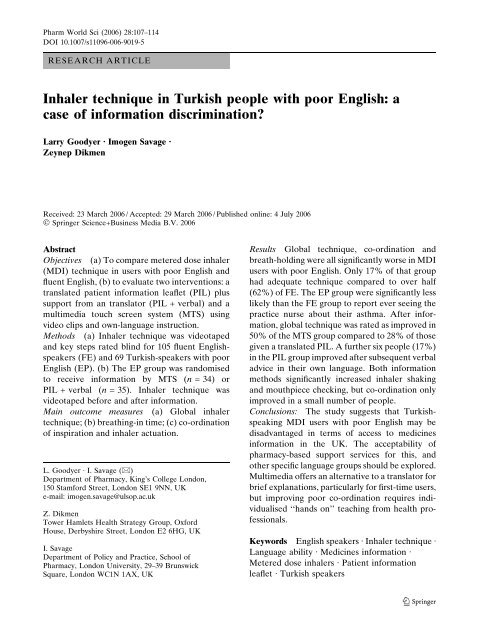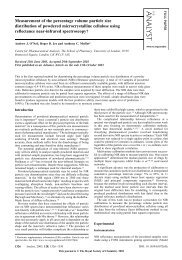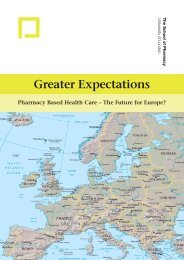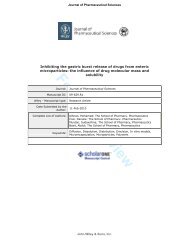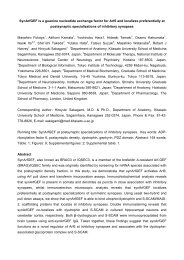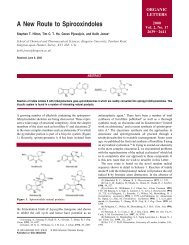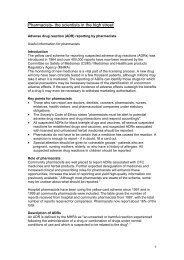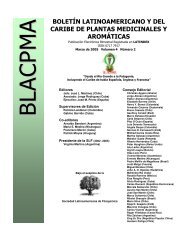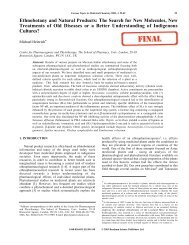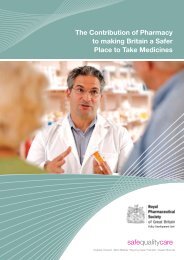Inhaler technique in Turkish people with poor English: a case of ...
Inhaler technique in Turkish people with poor English: a case of ...
Inhaler technique in Turkish people with poor English: a case of ...
Create successful ePaper yourself
Turn your PDF publications into a flip-book with our unique Google optimized e-Paper software.
Pharm World Sci (2006) 28:107–114<br />
DOI 10.1007/s11096-006-9019-5<br />
RESEARCH ARTICLE<br />
<strong>Inhaler</strong> <strong>technique</strong> <strong>in</strong> <strong>Turkish</strong> <strong>people</strong> <strong>with</strong> <strong>poor</strong> <strong>English</strong>: a<br />
<strong>case</strong> <strong>of</strong> <strong>in</strong>formation discrim<strong>in</strong>ation?<br />
Larry Goodyer Æ Imogen Savage Æ<br />
Zeynep Dikmen<br />
Received: 23 March 2006 / Accepted: 29 March 2006 / Published onl<strong>in</strong>e: 4 July 2006<br />
Ó Spr<strong>in</strong>ger Science+Bus<strong>in</strong>ess Media B.V. 2006<br />
Abstract<br />
Objectives (a) To compare metered dose <strong>in</strong>haler<br />
(MDI) <strong>technique</strong> <strong>in</strong> users <strong>with</strong> <strong>poor</strong> <strong>English</strong> and<br />
fluent <strong>English</strong>, (b) to evaluate two <strong>in</strong>terventions: a<br />
translated patient <strong>in</strong>formation leaflet (PIL) plus<br />
support from an translator (PIL + verbal) and a<br />
multimedia touch screen system (MTS) us<strong>in</strong>g<br />
video clips and own-language <strong>in</strong>struction.<br />
Methods (a) <strong>Inhaler</strong> <strong>technique</strong> was videotaped<br />
and key steps rated bl<strong>in</strong>d for 105 fluent <strong>English</strong>speakers<br />
(FE) and 69 <strong>Turkish</strong>-speakers <strong>with</strong> <strong>poor</strong><br />
<strong>English</strong> (EP). (b) The EP group was randomised<br />
to receive <strong>in</strong>formation by MTS (n = 34) or<br />
PIL + verbal (n = 35). <strong>Inhaler</strong> <strong>technique</strong> was<br />
videotaped before and after <strong>in</strong>formation.<br />
Ma<strong>in</strong> outcome measures (a) Global <strong>in</strong>haler<br />
<strong>technique</strong>; (b) breath<strong>in</strong>g-<strong>in</strong> time; (c) co-ord<strong>in</strong>ation<br />
<strong>of</strong> <strong>in</strong>spiration and <strong>in</strong>haler actuation.<br />
L. Goodyer Æ I. Savage (&)<br />
Department <strong>of</strong> Pharmacy, K<strong>in</strong>g’s College London,<br />
150 Stamford Street, London SE1 9NN, UK<br />
e-mail: imogen.savage@ulsop.ac.uk<br />
Z. Dikmen<br />
Tower Hamlets Health Strategy Group, Oxford<br />
House, Derbyshire Street, London E2 6HG, UK<br />
I. Savage<br />
Department <strong>of</strong> Policy and Practice, School <strong>of</strong><br />
Pharmacy, London University, 29–39 Brunswick<br />
Square, London WC1N 1AX, UK<br />
Results Global <strong>technique</strong>, co-ord<strong>in</strong>ation and<br />
breath-hold<strong>in</strong>g were all significantly worse <strong>in</strong> MDI<br />
users <strong>with</strong> <strong>poor</strong> <strong>English</strong>. Only 17% <strong>of</strong> that group<br />
had adequate <strong>technique</strong> compared to over half<br />
(62%) <strong>of</strong> FE. The EP group were significantly less<br />
likely than the FE group to report ever see<strong>in</strong>g the<br />
practice nurse about their asthma. After <strong>in</strong>formation,<br />
global <strong>technique</strong> was rated as improved <strong>in</strong><br />
50% <strong>of</strong> the MTS group compared to 28% <strong>of</strong> those<br />
given a translated PIL. A further six <strong>people</strong> (17%)<br />
<strong>in</strong> the PIL group improved after subsequent verbal<br />
advice <strong>in</strong> their own language. Both <strong>in</strong>formation<br />
methods significantly <strong>in</strong>creased <strong>in</strong>haler shak<strong>in</strong>g<br />
and mouthpiece check<strong>in</strong>g, but co-ord<strong>in</strong>ation only<br />
improved <strong>in</strong> a small number <strong>of</strong> <strong>people</strong>.<br />
Conclusions: The study suggests that <strong>Turkish</strong>speak<strong>in</strong>g<br />
MDI users <strong>with</strong> <strong>poor</strong> <strong>English</strong> may be<br />
disadvantaged <strong>in</strong> terms <strong>of</strong> access to medic<strong>in</strong>es<br />
<strong>in</strong>formation <strong>in</strong> the UK. The acceptability <strong>of</strong><br />
pharmacy-based support services for this, and<br />
other specific language groups should be explored.<br />
Multimedia <strong>of</strong>fers an alternative to a translator for<br />
brief explanations, particularly for first-time users,<br />
but improv<strong>in</strong>g <strong>poor</strong> co-ord<strong>in</strong>ation requires <strong>in</strong>dividualised<br />
‘‘hands on’’ teach<strong>in</strong>g from health pr<strong>of</strong>essionals.<br />
Keywords <strong>English</strong> speakers Æ <strong>Inhaler</strong> <strong>technique</strong> Æ<br />
Language ability Æ Medic<strong>in</strong>es <strong>in</strong>formation Æ<br />
Metered dose <strong>in</strong>halers Æ Patient <strong>in</strong>formation<br />
leaflet Æ <strong>Turkish</strong> speakers<br />
123
108 Pharm World Sci (2006) 28:107–114<br />
Introduction<br />
Good <strong>in</strong>formation on how to take or use medic<strong>in</strong>es<br />
is important if <strong>people</strong> are to get the most<br />
benefit from them. In the European Union,<br />
comprehensive leaflets for patients are now<br />
mandatory [1], and all medic<strong>in</strong>e packs should<br />
conta<strong>in</strong> a leaflet as a package <strong>in</strong>sert, produced by<br />
the manufacturer. In the United K<strong>in</strong>gdom, these<br />
leaflets are written <strong>in</strong> <strong>English</strong>. Translation support<br />
for patients is available <strong>in</strong> hospitals and primary<br />
care, but provision is patchy and services<br />
over-stretched.<br />
People whose first language is not <strong>English</strong> (non-<br />
EFL) may therefore, have difficulty <strong>in</strong> access<strong>in</strong>g<br />
<strong>in</strong>formation about their medic<strong>in</strong>es. This puts them<br />
at a significant disadvantage, yet there has been<br />
relatively little research [2, 3] <strong>in</strong> this area.<br />
Asthma is one example <strong>of</strong> a condition where<br />
the <strong>in</strong>ability to understand and use pr<strong>in</strong>ted<br />
<strong>in</strong>formation (functional illiteracy) could compromise<br />
effective management. The metered dose<br />
<strong>in</strong>haler (MDI) is the first choice device for most<br />
<strong>people</strong> <strong>with</strong> asthma but these devices are not easy<br />
to use well [4–7] and many patients have problems.<br />
If the <strong>in</strong>haler is pressed before the person<br />
starts to breathe <strong>in</strong>, then a good portion <strong>of</strong> the<br />
released dose will be lost. It is also important that<br />
the user breathes <strong>in</strong> deeply, and then holds their<br />
breath, to maximise drug delivery to the lungs.<br />
Good <strong>in</strong>struction can help to overcome these<br />
difficulties, [8, 9] particularly <strong>in</strong> relation to a <strong>poor</strong><br />
hand/lung co-ord<strong>in</strong>ation. However, regular review<br />
takes staff time [10] and is not universally available.<br />
For many users <strong>in</strong> the UK, the first and only<br />
<strong>in</strong>formation they get on how to use their <strong>in</strong>haler is<br />
the patient <strong>in</strong>formation leaflet (PIL) <strong>in</strong>side the<br />
pack. People <strong>with</strong> <strong>poor</strong> <strong>English</strong> read<strong>in</strong>g skills may<br />
not be able to understand this <strong>in</strong>formation, and<br />
could use their <strong>in</strong>haler <strong>in</strong>correctly, result<strong>in</strong>g <strong>in</strong><br />
sub-optimal dos<strong>in</strong>g and sub-optimal response.<br />
The first aim <strong>of</strong> this study was to test this<br />
hypothesis by compar<strong>in</strong>g <strong>in</strong>haler <strong>technique</strong> <strong>in</strong><br />
MDI users <strong>with</strong> <strong>poor</strong> <strong>English</strong> (EP) and <strong>people</strong><br />
whose first language was <strong>English</strong> (FE). For the<br />
EP group, we chose to study <strong>people</strong> <strong>of</strong> <strong>Turkish</strong><br />
orig<strong>in</strong>, as previous work [11] <strong>in</strong> Har<strong>in</strong>gey, London<br />
had suggested the language barrier was a significant<br />
factor <strong>in</strong> medic<strong>in</strong>es compliance.<br />
123<br />
The second aim was to evaluate two <strong>in</strong>terventions:<br />
a translated PIL plus verbal support from a<br />
translator, and a multimedia touch screen system<br />
(MTS) which provides the same <strong>in</strong>formation<br />
us<strong>in</strong>g video clips <strong>of</strong> an actual demonstration<br />
<strong>with</strong> own-language voice-over <strong>in</strong>struction. It was<br />
hypothesised that the MTS system might reduce<br />
the need for translator support.<br />
Method<br />
This was a s<strong>in</strong>gle bl<strong>in</strong>d randomised controlled<br />
trial <strong>with</strong> two groups: MTS and a translated leaflet<br />
plus support from a translator fluent <strong>in</strong> <strong>Turkish</strong><br />
and <strong>English</strong> (PIL + verbal).<br />
Patient allocation was done us<strong>in</strong>g random<br />
number tables. Patients did not know <strong>in</strong> advance<br />
which <strong>in</strong>formation method they would receive.<br />
The MTS system covered the material shown<br />
<strong>in</strong> Table 1 <strong>with</strong> additional <strong>in</strong>formation on posture.<br />
The subject could <strong>in</strong>teract <strong>with</strong> the program<br />
by select<strong>in</strong>g to replay a step, or move on to the<br />
next one.<br />
The leaflet was produced by one <strong>of</strong> the authors<br />
(ZD) and was an exact translation <strong>of</strong> the current<br />
version <strong>of</strong> Allen and Hanbury’s PIL for the<br />
Ventol<strong>in</strong> MDI.<br />
Patient recruitment<br />
All recruits gave their <strong>in</strong>formed consent to the<br />
study, which was approved by the relevant local<br />
ethics committees.<br />
Fluent <strong>English</strong>-speak<strong>in</strong>g MDI users <strong>of</strong> non-<br />
<strong>Turkish</strong> orig<strong>in</strong> who had been us<strong>in</strong>g an <strong>in</strong>haler for<br />
more than 3 months were recruited through GP<br />
practices <strong>in</strong> Har<strong>in</strong>gey and Camden, and assessed<br />
<strong>in</strong> the surgery. Read<strong>in</strong>g ability was not formally<br />
assessed, but the recruitment method provided<br />
strong evidence that every volunteer had at least<br />
average literacy. Participants were recruited by<br />
letter and had to reply <strong>in</strong> writ<strong>in</strong>g, provid<strong>in</strong>g some<br />
<strong>in</strong>itial <strong>in</strong>formation. Their responses could be validated<br />
aga<strong>in</strong>st their handwrit<strong>in</strong>g on the consent<br />
form which was completed <strong>in</strong> the surgery before<br />
<strong>in</strong>haler <strong>technique</strong> was assessed.<br />
Initially, <strong>Turkish</strong>-speakers (<strong>Turkish</strong> first language;<br />
not fluent <strong>in</strong> <strong>English</strong>) were recruited<br />
through GP surgeries <strong>in</strong> Camden but this was not
Pharm World Sci (2006) 28:107–114 109<br />
Table 1 Information po<strong>in</strong>ts<br />
h Take cover <strong>of</strong>f and check the mouthpiece is clean<br />
h Shake the <strong>in</strong>haler well<br />
h Hold the <strong>in</strong>haler upright <strong>with</strong> thumb on the base, below<br />
the mouthpiece<br />
h Breathe out normally<br />
h Close lips firmly around the mouthpiece<br />
h Start to breathe <strong>in</strong>, then press down on top <strong>of</strong> the <strong>in</strong>haler.<br />
Keep on breath<strong>in</strong>g <strong>in</strong> steadily and deeply<br />
h Take <strong>in</strong>haler from mouth<br />
h Hold breath for as long as is comfortable<br />
successful; <strong>of</strong> 100 <strong>in</strong>vited to attend only 10<br />
accepted. A ‘‘snowball’’ convenience sampl<strong>in</strong>g<br />
method was therefore used, us<strong>in</strong>g contacts <strong>in</strong><br />
social clubs and <strong>in</strong>formal networks <strong>in</strong> Tower<br />
Hamlets and Camden. Subjects were assessed<br />
ma<strong>in</strong>ly <strong>in</strong> their own homes. Written and spoken<br />
skills <strong>in</strong> <strong>English</strong> and <strong>Turkish</strong> were assessed us<strong>in</strong>g a<br />
language pr<strong>of</strong>iciency test devised by the Language<br />
Department at K<strong>in</strong>g’s College London.<br />
This <strong>in</strong>cluded be<strong>in</strong>g asked to read and expla<strong>in</strong> an<br />
<strong>English</strong> phrase and to answer the question: ‘‘what<br />
medic<strong>in</strong>es do you have now?’’<br />
Table 2 shows population data on literacy and<br />
birthplace for the three study areas.<br />
Study procedure<br />
Sessions for the EP group were run by a <strong>Turkish</strong><br />
pharmacist (ZD) who acted as both researcher<br />
and translator. The procedure for the <strong>English</strong><br />
group has been reported elsewhere [12]. Demographic<br />
and treatment-related <strong>in</strong>formation (see<br />
Table 3) was collected before each patient was<br />
Table 2 Area demography<br />
Area Total<br />
population<br />
% born outside<br />
UK/Eire<br />
Har<strong>in</strong>gey 216,507 34.4% 5.3<br />
Tower Hamlets 196,106 33.4% 10.6<br />
Camden 198,020 33.6% 5.1<br />
London 7,172,091 24.9% 4.9<br />
England 49,138,831 8.3% 4.0<br />
% very low<br />
literacy*<br />
*Data from Census 2001 and Basic Skills Agency<br />
Very low literacy: difficulties <strong>in</strong> cop<strong>in</strong>g <strong>with</strong> everyday<br />
read<strong>in</strong>g and numbers; need <strong>in</strong>tensive help to reach<br />
m<strong>in</strong>imum standard. Includes <strong>people</strong> <strong>with</strong> learn<strong>in</strong>g<br />
difficulties<br />
assessed. As the time per patient was limited, only<br />
basic <strong>in</strong>formation was collected. Participants were<br />
not asked about their educational history, or for<br />
details <strong>of</strong> their current job. Access to GP records<br />
was only possible for the EP group. Asthma<br />
severity <strong>in</strong> the two groups could therefore not be<br />
compared.<br />
Recruits gave written consent for a videotape<br />
to be made. They then demonstrated to the<br />
camera the use <strong>of</strong> the MDI, <strong>with</strong>out a spacer<br />
device, us<strong>in</strong>g a placebo canister placed <strong>in</strong>to their<br />
own holder. Technique was demonstrated twice;<br />
before and after view<strong>in</strong>g <strong>in</strong>formation.<br />
Patients were allowed to use the program, or<br />
study the leaflet for as long as they wished before<br />
repeat<strong>in</strong>g the demonstration. The researcher/<br />
translator identified areas where <strong>technique</strong> could<br />
be improved, then spent up to 15 m<strong>in</strong> discuss<strong>in</strong>g<br />
this <strong>with</strong> the user. A f<strong>in</strong>al video record<strong>in</strong>g was<br />
then made.<br />
This allowed the effect <strong>of</strong> the <strong>in</strong>formation<br />
alone to be separated from the comb<strong>in</strong>ed effect <strong>of</strong><br />
PIL + translator support.<br />
Assessment <strong>of</strong> <strong>in</strong>haler <strong>technique</strong><br />
Videotaped demonstrations were digitised, compressed<br />
to MPEG format and transferred to<br />
CD-ROM. They were subsequently assessed by<br />
two pharmacists <strong>with</strong> experience <strong>in</strong> respiratory<br />
medic<strong>in</strong>e. These assessors did not attend experimental<br />
sessions and had no contact <strong>with</strong> patient<br />
volunteers. They were therefore, bl<strong>in</strong>d as to the<br />
<strong>in</strong>formation format, but not as to the patient’s<br />
probable ethnic orig<strong>in</strong>.<br />
First, the assessors were asked to play the clip<br />
through <strong>with</strong>out stopp<strong>in</strong>g and to rate global<br />
<strong>technique</strong> as <strong>poor</strong>, adequate or good. This would<br />
probably approximate to a ‘‘quick check’’ <strong>of</strong><br />
<strong>technique</strong> performed <strong>in</strong> the cl<strong>in</strong>ic. Poor <strong>technique</strong><br />
was def<strong>in</strong>ed as any <strong>of</strong> the follow<strong>in</strong>g:<br />
– press<strong>in</strong>g the canister before <strong>in</strong>spiration<br />
– visible ‘‘mist’’ escap<strong>in</strong>g from the mouth<br />
– no significant <strong>in</strong>halation observed<br />
– not releas<strong>in</strong>g a dose at all<br />
Assessors then assessed <strong>technique</strong> <strong>in</strong> detail us<strong>in</strong>g<br />
a checklist. The <strong>in</strong>dividual steps shown <strong>in</strong><br />
Table 1 were scored as correct or <strong>in</strong>correct.<br />
123
110 Pharm World Sci (2006) 28:107–114<br />
Table 3 Subject details<br />
<strong>Inhaler</strong>-shak<strong>in</strong>g (counts) and length <strong>of</strong> <strong>in</strong>spiration<br />
(seconds) were assessed directly from the videotape<br />
record<strong>in</strong>gs. The variable ‘‘breath<strong>in</strong>g-<strong>in</strong>’’ was<br />
def<strong>in</strong>ed as the time <strong>in</strong>terval between start<strong>in</strong>g to<br />
breathe <strong>in</strong> and exhal<strong>in</strong>g.<br />
Rater reliability<br />
Intra-rater<br />
Demonstrations from a purposive sample <strong>of</strong> 12<br />
patients, chosen to illustrate the range <strong>of</strong> good<br />
and <strong>poor</strong> <strong>technique</strong>, were rated twice. There was<br />
good agreement between the two data sets<br />
(Global <strong>technique</strong>: Chi-square df 4 P < 0.002;<br />
co-ord<strong>in</strong>ation: kappa 0.795 P < 0.0001).<br />
Inter-rater<br />
All kappa scores for <strong>in</strong>dividual observations were<br />
positive and comparison <strong>of</strong> all observations yielded<br />
a median kappa score <strong>of</strong> 0.5 (quartile range<br />
0.32–0.75). Whilst this demonstrates only a modest<br />
level <strong>of</strong> agreement, assess<strong>in</strong>g breath<strong>in</strong>g patterns<br />
was <strong>of</strong>ten a problem. ‘‘Difficult to assess’’<br />
subjects were equally distributed between groups.<br />
Statistical analysis<br />
Chi-square test (categorical variables) and <strong>in</strong>dependent<br />
t-tests (cont<strong>in</strong>uous normally distributed<br />
123<br />
variables) were used to compare basel<strong>in</strong>e data <strong>in</strong><br />
the <strong>English</strong> and <strong>Turkish</strong> groups.<br />
Global <strong>technique</strong> rat<strong>in</strong>gs before and after<br />
<strong>in</strong>formation were compared and subjects categorised<br />
as improved, no change, or worse.<br />
Chi-square test was used for differences <strong>in</strong> proportions.<br />
The sign test was used for checklist<br />
variables; the paired t-test for <strong>in</strong>haler-shak<strong>in</strong>g<br />
frequency and breath<strong>in</strong>g-<strong>in</strong> time.<br />
Results<br />
Fluent <strong>English</strong><br />
N = 105<br />
<strong>Turkish</strong>-speak<strong>in</strong>g<br />
N =69<br />
Age (years)<br />
Mean +/) sd<br />
Age group<br />
51 +/) 20.9 42 +/) 17.5<br />
Pharm World Sci (2006) 28:107–114 111<br />
Approximately, a quarter <strong>of</strong> both language<br />
groups said they had not received <strong>in</strong>itial <strong>in</strong>struction<br />
from a health pr<strong>of</strong>essional on how to use<br />
their <strong>in</strong>halers. There was no difference <strong>in</strong> use <strong>of</strong><br />
spac<strong>in</strong>g devices: approximately a third <strong>of</strong> both<br />
groups used these for at least some <strong>of</strong> their doses.<br />
The EP group were significantly less likely to report<br />
see<strong>in</strong>g the practice nurse about their asthma<br />
than the FE group. Nearly half (45%) the EP<br />
group said they never saw the nurse, compared<br />
<strong>with</strong> 25% <strong>of</strong> the <strong>English</strong>-speak<strong>in</strong>g group. (Chi<br />
square = 6.8, df 1, P < 0.01).<br />
Tables 4 and 5 compare <strong>in</strong>haler <strong>technique</strong>.<br />
<strong>Turkish</strong>-speakers performed better than <strong>English</strong>speakers<br />
<strong>in</strong> terms <strong>of</strong> shak<strong>in</strong>g the <strong>in</strong>haler and were<br />
more likely to check the mouthpiece. However,<br />
there was a marked difference <strong>in</strong> global scores for<br />
<strong>in</strong>haler <strong>technique</strong>, <strong>in</strong> co-ord<strong>in</strong>ation, and <strong>in</strong> breathhold<strong>in</strong>g,<br />
all <strong>of</strong> which were significantly worse <strong>in</strong><br />
the group <strong>with</strong> <strong>poor</strong> <strong>English</strong>.<br />
Impact <strong>of</strong> <strong>in</strong>terventions <strong>in</strong> group <strong>with</strong> <strong>poor</strong><br />
<strong>English</strong><br />
Thirty-four <strong>Turkish</strong> patients <strong>with</strong> EP were<br />
randomised to the MTS group and thirty-five to<br />
the PIL/verbal group. Groups were well matched<br />
for age, gender and basel<strong>in</strong>e (before <strong>in</strong>formation)<br />
<strong>in</strong>haler <strong>technique</strong> rat<strong>in</strong>gs. Only 4 <strong>of</strong> the 35 <strong>people</strong><br />
<strong>in</strong> the MTS group had used a computer. Despite<br />
this, they needed little <strong>in</strong>struction on use <strong>of</strong> the<br />
system.<br />
Changes <strong>in</strong> <strong>in</strong>haler <strong>technique</strong> after <strong>in</strong>formation<br />
are presented <strong>in</strong> Tables 6–8. Half the MTS group<br />
were rated as improved compared to 28% <strong>of</strong><br />
those given a translated leaflet. A further six<br />
<strong>people</strong> (17%) improved after subsequent verbal<br />
advice <strong>in</strong> their own language.<br />
Table 4 Global <strong>technique</strong> assessments <strong>in</strong> fluent <strong>English</strong>speakers<br />
and <strong>Turkish</strong>-speakers <strong>with</strong> <strong>poor</strong> <strong>English</strong><br />
Global <strong>technique</strong> rat<strong>in</strong>g<br />
Poor Adequate Good Total<br />
Fluent <strong>English</strong> 36 48 11 95<br />
(37.9%) (50.5%) (11.6%)<br />
Poor <strong>English</strong> 57 12 0 69<br />
(83%) (17%) –<br />
Chi-square = 30.36 df 2 P < 0.0001<br />
Many subjects had shallow breath<strong>in</strong>g which<br />
made accurate assessment difficult. In some <strong>case</strong>s,<br />
they failed to take any perceptible <strong>in</strong>halation and<br />
five failed to release a dose. Own-language verbal<br />
<strong>in</strong>struction after read<strong>in</strong>g the PIL produced small<br />
but statistically significant improvement <strong>in</strong><br />
breath-hold<strong>in</strong>g.<br />
<strong>Inhaler</strong>-shak<strong>in</strong>g and mouthpiece-check<strong>in</strong>g<br />
improved significantly <strong>in</strong> both groups after <strong>in</strong>formation.<br />
The proportion <strong>of</strong> patients <strong>with</strong> correct<br />
co-ord<strong>in</strong>ation also <strong>in</strong>creased <strong>in</strong> both groups but<br />
numbers were small and changes did not reach<br />
statistical significance.<br />
Multiple quick actuation <strong>of</strong> the <strong>in</strong>haler was<br />
observed <strong>in</strong> 21% MTS and 20% PIL/verbal<br />
before <strong>in</strong>struction. This problem was resolved <strong>in</strong><br />
most subjects by all modes <strong>of</strong> <strong>in</strong>struction.<br />
Discussion<br />
The <strong>in</strong>haler users <strong>with</strong> FE and EP <strong>in</strong> this study<br />
came from three London boroughs <strong>with</strong> diverse<br />
mix <strong>of</strong> ethnic backgrounds and languages.<br />
Approximately, a third <strong>of</strong> the local population <strong>in</strong><br />
each borough had been born outside the UK. All<br />
participants were volunteers who were <strong>in</strong>terested<br />
<strong>in</strong> hav<strong>in</strong>g an ‘‘<strong>in</strong>haler <strong>technique</strong> check’’. The FE<br />
group could all read <strong>English</strong>; most <strong>of</strong> the EP<br />
group could not.<br />
The FE and EP groups were recruited by different<br />
methods, and assessed <strong>in</strong> different sett<strong>in</strong>gs.<br />
We did not take an education history, but the<br />
broad occupational pr<strong>of</strong>ile <strong>of</strong> the two groups was<br />
clearly different, <strong>with</strong> more retired <strong>people</strong> <strong>in</strong> the<br />
<strong>English</strong> group and more women look<strong>in</strong>g after the<br />
home <strong>in</strong> the <strong>Turkish</strong> group.<br />
<strong>Inhaler</strong> <strong>technique</strong> <strong>in</strong> the FE group was <strong>in</strong> l<strong>in</strong>e<br />
<strong>with</strong> previous reports, [5–9] <strong>with</strong> around a third<br />
graded as <strong>poor</strong> and two-thirds hav<strong>in</strong>g some<br />
co-ord<strong>in</strong>ation deficiencies. Global <strong>technique</strong> <strong>in</strong><br />
the EP group was almost universally rated as<br />
<strong>poor</strong>, <strong>with</strong> some extreme co-ord<strong>in</strong>ation problems<br />
observed. It was not possible to compare asthma<br />
severity <strong>in</strong> the two groups, as the researchers only<br />
had access to GP records for patients recruited<br />
through surgeries. However, the reported prescrib<strong>in</strong>g<br />
<strong>of</strong> large volume spacer devices (roughly a<br />
third <strong>of</strong> both groups said they used a spacer)<br />
123
112 Pharm World Sci (2006) 28:107–114<br />
Table 5 Comparison <strong>of</strong><br />
key steps <strong>in</strong> <strong>technique</strong> <strong>in</strong><br />
fluent <strong>English</strong>-speakers<br />
and <strong>Turkish</strong>-speakers<br />
<strong>with</strong> <strong>poor</strong> <strong>English</strong><br />
Shakes <strong>in</strong>haler<br />
(% correct)<br />
suggests that GP perception <strong>of</strong> cl<strong>in</strong>ical need was<br />
similar <strong>in</strong> the two groups.<br />
The majority <strong>of</strong> participants <strong>in</strong> both FE and EP<br />
groups said they remembered a demonstration <strong>of</strong><br />
how to use their <strong>in</strong>haler when it was first prescribed.<br />
In addition, they would all have received<br />
the manufacturer’s PIL, which is <strong>in</strong>cluded <strong>in</strong><br />
every <strong>in</strong>haler pack. These mandatory leaflets,<br />
def<strong>in</strong>ed by EU regulations, act as a reference<br />
source for the patient and family and carers and<br />
are <strong>in</strong>tended to complement and re<strong>in</strong>force any<br />
verbal advice from health pr<strong>of</strong>essionals. PILs for<br />
asthma <strong>in</strong>halers provide illustrations <strong>of</strong> the key<br />
steps <strong>in</strong> correct use, but these need to be viewed<br />
<strong>in</strong> conjunction <strong>with</strong> the text to be fully understood.<br />
It is therefore, reasonable to propose that the<br />
<strong>in</strong>ability to read and understand the written<br />
<strong>in</strong>formation on how to use their <strong>in</strong>haler may have<br />
made it more difficult for the EP group to develop<br />
good <strong>in</strong>haler <strong>technique</strong>. Cultural differences <strong>in</strong><br />
the use <strong>of</strong> primary care preventive services would<br />
have perpetuated this <strong>in</strong>formation deficit. Our EP<br />
sample was hard to recruit through surgeries, and<br />
also much less likely than the FE group to use<br />
non-acute services such as nurse-run asthma<br />
cl<strong>in</strong>ics. There were therefore, fewer opportunities<br />
for nurses and GPs to pick up and correct misunderstand<strong>in</strong>gs<br />
about <strong>technique</strong>.<br />
Table 6 Global <strong>technique</strong> change after <strong>in</strong>tervention <strong>in</strong><br />
<strong>poor</strong> <strong>English</strong>-speakers<br />
n shakes<br />
(sd)<br />
Checks<br />
mouthpiece<br />
(% correct)<br />
Co-ord<strong>in</strong>ation<br />
(% correct)<br />
Breath<strong>in</strong>g-<strong>in</strong><br />
time(secs)<br />
Fluent <strong>English</strong> 59(59%) 4.7 (5.9) 4 (4%) 28 (29.5%) 7.8 (4.4)<br />
n = 100 n =99 n = 100 n =95 n =52<br />
Poor <strong>English</strong> 38 (55%) 7.0 (4.1) 10 (14.5%) 8 (11.6%) 4.8 (6.3)<br />
n =69 n =40 n =69 n =69 n =52<br />
Difference ns P < 0.05 P < 0.01 P < 0.02 ns<br />
MTS PIL + translator<br />
After<br />
PIL<br />
After<br />
PIL + verbal<br />
Worse than basel<strong>in</strong>e 5 (15%) 5 (16%) 4 (11%)<br />
No change 12 (35%) 18 (56%) 16 (48%)<br />
Better than basel<strong>in</strong>e 17 (50%) 9 (28%) 15 (45%)<br />
123<br />
Poor read<strong>in</strong>g skills are not just a problem for<br />
<strong>people</strong> whose first language is not <strong>English</strong>.<br />
Nationally 4 <strong>in</strong> 10 adults have been estimated[13]<br />
to have difficulties <strong>in</strong> cop<strong>in</strong>g <strong>with</strong> everyday literacy<br />
and numeracy requirements. A recent survey<br />
[14] found that 15% <strong>of</strong> 127 consecutive patients<br />
(125 Caucasian) attend<strong>in</strong>g a rheumatoid arthritis<br />
cl<strong>in</strong>ic were functionally illiterate. These patients<br />
did not have more severe disease than patients<br />
who could read <strong>in</strong>formation about their condition,<br />
but were more anxious and visited hospital<br />
more <strong>of</strong>ten.<br />
Motivation to read and the perceived authority<br />
<strong>of</strong> the <strong>in</strong>formation source are also factors. All <strong>of</strong><br />
our volunteers <strong>with</strong> FE were able to read, yet a<br />
proportion also had <strong>poor</strong> <strong>technique</strong>. FE asthmatics[15]<br />
do not always look at PILs, or see<br />
them as important. They place a higher value on<br />
face-to-face <strong>in</strong>dividualised advice.<br />
Properly bl<strong>in</strong>ded studies <strong>of</strong> <strong>in</strong>terventions to<br />
improve <strong>in</strong>haler <strong>technique</strong> have rarely been<br />
attempted. The present study has attempted to<br />
overcome the problem <strong>of</strong> bias by film<strong>in</strong>g patients<br />
us<strong>in</strong>g their <strong>in</strong>halers and then digitis<strong>in</strong>g the films<br />
for ‘‘bl<strong>in</strong>d’’ assessment. Decid<strong>in</strong>g if chest movement<br />
had occurred was sometimes very difficult,<br />
and this may expla<strong>in</strong> the relatively low level <strong>of</strong><br />
agreement between assessors.<br />
Bear<strong>in</strong>g this weakness <strong>in</strong> m<strong>in</strong>d, brief exposure<br />
to own-language <strong>in</strong>formation presented via multimedia<br />
and a translated leaflet <strong>with</strong> translator<br />
support appeared to be equally effective <strong>in</strong><br />
chang<strong>in</strong>g what some <strong>in</strong>haler users did, at least <strong>in</strong><br />
the short term.<br />
Approximately, half the subjects had improved<br />
their <strong>technique</strong> after <strong>in</strong>formation given by either<br />
method. The effect <strong>of</strong> written translated <strong>in</strong>formation<br />
alone was smaller; only one quarter <strong>of</strong><br />
subjects improved after a leaflet.
Pharm World Sci (2006) 28:107–114 113<br />
Both <strong>in</strong>formation methods resulted <strong>in</strong> small but<br />
statistically significant improvements <strong>in</strong> some<br />
<strong>in</strong>dividual <strong>technique</strong> steps, although co-ord<strong>in</strong>ation,<br />
the most important aspect <strong>of</strong> <strong>technique</strong>, was only<br />
improved <strong>in</strong> a small number <strong>of</strong> <strong>people</strong>.<br />
Conclusions<br />
There were demographic differences between our<br />
two language groups, and this is an acknowledged<br />
weakness <strong>in</strong> this study. However, we do not<br />
believe that these differences alone expla<strong>in</strong> why<br />
<strong>in</strong>haler <strong>technique</strong> <strong>in</strong> the <strong>people</strong> <strong>with</strong> <strong>poor</strong> <strong>English</strong><br />
was so much worse than <strong>in</strong> the FE users <strong>of</strong> the<br />
same <strong>in</strong>haler (Ventol<strong>in</strong>). Discrim<strong>in</strong>ation <strong>in</strong> terms<br />
<strong>of</strong> access to the written <strong>in</strong>formation supplied <strong>in</strong>side<br />
every <strong>in</strong>haler pack also needs to be considered.<br />
The <strong>in</strong>terventions we tested suggested that a<br />
translated PIL, used alone, is <strong>of</strong> less benefit than<br />
the same leaflet used together <strong>with</strong> own-language<br />
verbal advice. This supports others [3, 16] who<br />
have concluded that it is simplistic to propose that<br />
written translation alone is the answer to the<br />
language barrier when provid<strong>in</strong>g medic<strong>in</strong>es<br />
<strong>in</strong>formation. The <strong>Turkish</strong> <strong>in</strong>haler-users <strong>in</strong> our<br />
study were mostly literate <strong>in</strong> their mother tongue<br />
but the assumption that if you can speak a language<br />
then you can read it is not necessarily<br />
true[13], either for native <strong>English</strong> speakers or for<br />
foreigners.<br />
A broad portfolio <strong>of</strong> methods, <strong>in</strong>clud<strong>in</strong>g pictograms,<br />
audiotapes and computer and web-based<br />
multimedia (available through term<strong>in</strong>als <strong>in</strong> surgeries,<br />
pharmacies and other public <strong>in</strong>formation<br />
po<strong>in</strong>ts) needs to be developed if all patients are to<br />
Table 7 Categorical <strong>technique</strong> variables (paired data; sign test)<br />
Technique<br />
measure<br />
Checks mouthpiece<br />
(n correct)<br />
Shakes <strong>in</strong>haler<br />
(n correct)<br />
Co-ord<strong>in</strong>ation<br />
(n correct)<br />
Multimedia group Leaflet + translator group<br />
N <strong>case</strong>s Before<br />
<strong>in</strong>fo<br />
After<br />
MTS<br />
P<br />
value<br />
have equal access to good medic<strong>in</strong>es <strong>in</strong>formation.<br />
Lack <strong>of</strong> computer experience need not be a barrier.<br />
The majority <strong>of</strong> <strong>Turkish</strong>-speak<strong>in</strong>g subjects<br />
and elderly <strong>English</strong> subjects had little or no<br />
experience but found the method both easy and<br />
enjoyable.<br />
The ability to <strong>of</strong>fer patients a choice <strong>of</strong> language<br />
makes multimedia systems useful educational<br />
tools but they are not a panacea to the<br />
problem <strong>of</strong> <strong>poor</strong> <strong>in</strong>haler <strong>technique</strong>. Our volunteers<br />
were long-term <strong>in</strong>haler users, <strong>with</strong> deeply<br />
<strong>in</strong>gra<strong>in</strong>ed habits. The impact <strong>of</strong> <strong>in</strong>formation on<br />
their <strong>in</strong>haler <strong>technique</strong> was modest at best, and<br />
co-ord<strong>in</strong>ation did not improve <strong>in</strong> the majority <strong>of</strong><br />
patients tested.<br />
Greater benefits could be expected <strong>in</strong> <strong>people</strong><br />
us<strong>in</strong>g <strong>in</strong>halers for the first time, and a multimedia<br />
touch-screen computer could <strong>of</strong>fer a convenient<br />
alternative to the use <strong>of</strong> a translator for the brief<br />
explanations normally given <strong>in</strong> surgery or pharmacy.<br />
However, the f<strong>in</strong>d<strong>in</strong>gs demonstrate that<br />
<strong>in</strong>formation alone is rarely enough to change<br />
behaviour. To improve <strong>poor</strong> co-ord<strong>in</strong>ation, the<br />
<strong>in</strong>haler user first needs to see and understand<br />
what he is do<strong>in</strong>g wrong, and then to practise until<br />
the correct method becomes automatic. This<br />
learn<strong>in</strong>g process needs practical one-to-one<br />
teach<strong>in</strong>g from someone who can demonstrate<br />
correct MDI <strong>technique</strong>. In our study, the video<br />
camera was a very useful teach<strong>in</strong>g and learn<strong>in</strong>g<br />
tool.<br />
This study suggests that a significant proportion<br />
<strong>of</strong> <strong>in</strong>haler users <strong>with</strong> <strong>poor</strong> <strong>English</strong> may never<br />
attend GP asthma check cl<strong>in</strong>ics, and only visit the<br />
surgery when they become ill. However, all<br />
<strong>in</strong>haler users must present their prescriptions to a<br />
pharmacist. The acceptability and feasibility <strong>of</strong><br />
N <strong>case</strong>s Before<br />
<strong>in</strong>fo<br />
After<br />
PIL<br />
P<br />
value<br />
After PIL +<br />
verbal advice<br />
P<br />
value<br />
34 8 (23%) 16 (47%) 0.05 35 2 (6%) 1 (3%) ns 11 (31%) 0.004<br />
34 16 (47%) 24 (72%) 0.04 35 22 (62%) 16 (46%) ns 35 (100%) 0.001<br />
34 4 (12%) 11 (35%) ns 35 4 (11%) 6 (18%) ns 10 (28%) ns<br />
123
114 Pharm World Sci (2006) 28:107–114<br />
Table 8 Cont<strong>in</strong>uous <strong>technique</strong> variables (paired data; paired t-test)<br />
Technique measure Multimedia group<br />
<strong>Inhaler</strong> shak<strong>in</strong>g<br />
(n times)<br />
Breath<strong>in</strong>g-<strong>in</strong> time<br />
(secs)<br />
<strong>Inhaler</strong> shak<strong>in</strong>g<br />
(n times)<br />
Breath<strong>in</strong>g-<strong>in</strong> time<br />
(secs)<br />
pharmacy-based services targeted at specific<br />
language groups should be <strong>in</strong>vestigated.<br />
Acknowledgements The authors would like to thank<br />
everyone who took part <strong>in</strong> the study, or provided facilities<br />
and support. The study was funded by the Department <strong>of</strong><br />
Health, and the North London Primary Care Research<br />
Network (Nocten).<br />
Possible conflicts <strong>of</strong> <strong>in</strong>terest None.<br />
References<br />
N<br />
<strong>case</strong>s<br />
Before<br />
<strong>in</strong>fo<br />
After<br />
MTS<br />
1. Directive 2001/83/EC <strong>of</strong> the European Parliament and<br />
<strong>of</strong> the Council <strong>of</strong> 6 November 2001 on the Community<br />
code relat<strong>in</strong>g to medic<strong>in</strong>al products for human use.<br />
Official Journal L 311, 28 November 2001:p20<br />
2. Shaw J, Hemm<strong>in</strong>g MP, Hobson JD, Marty JJ (1977)<br />
Comparison <strong>of</strong> <strong>English</strong> and non-<strong>English</strong> speak<strong>in</strong>g<br />
outpatients comprehension <strong>of</strong> medications. Aust J<br />
Hosp Pharm 7(3):116–119<br />
3. Jesson J, Sadler S, Pocock R, Jepson M (1995) Ethnic<br />
m<strong>in</strong>ority consumers <strong>of</strong> community pharmaceutical<br />
services. Int J Pharm Pract 3:129–132<br />
4. Paterson LC, Crompton GK (1976) Use <strong>of</strong> pressurised<br />
aerosols by asthmatic patients. BMJ 1:76–77<br />
5. Hilton S (1990) An audit <strong>of</strong> <strong>in</strong>haler <strong>technique</strong> among<br />
asthma patients <strong>of</strong> 34 general practitioners. Br J Gen<br />
Pract 40:505–506<br />
6. Nimmo CJ, Chen DN, Mart<strong>in</strong>usen SM, Ustad TL (1993)<br />
Assessment <strong>of</strong> patient acceptance and <strong>in</strong>halation <strong>technique</strong><br />
<strong>of</strong> a pressurized aerosol <strong>in</strong>haler and two breathactuated<br />
devices. Ann Pharmacother 27:922–927<br />
123<br />
Difference<br />
(95% cl)<br />
34 3.0 6.2 +3.2 (1–5.4) 0.06<br />
26 3.9 4.5 +0.6 ()1.4–2.6) ns<br />
Leaflet + translator group<br />
N<br />
<strong>case</strong>s<br />
Before<br />
<strong>in</strong>fo<br />
After<br />
PIL<br />
Difference<br />
(95% cl)<br />
p<br />
p After PIL +<br />
verbal advice<br />
Difference<br />
(95% cl)<br />
34 5.0 5.7 )0.68 ()0.1–2.5) ns 8.0 +3 (1–4.9) 0.001<br />
17 1.8 3.2 +1.3 ()0.5–2.7) ns 5.4 +3.6 (2–5) 0.001<br />
7. Larsen JS, Hahn M, Ekholm B, Wick KA (1994).<br />
Evaluation <strong>of</strong> conventional press-and-breathe metered-dose<br />
<strong>in</strong>haler <strong>technique</strong> <strong>in</strong> 501 patients. J Asthma<br />
31:193–199<br />
8. Self TE, Brooks JB, Lieberman P, Ryan MR (1983).<br />
The value <strong>of</strong> demonstration and the role <strong>of</strong> the pharmacist<br />
<strong>in</strong> teach<strong>in</strong>g the correct use <strong>of</strong> pressurised<br />
bronchodilators. Can Med Assoc J 62:3–21<br />
9. Dick<strong>in</strong>son J, Hutton S, Atk<strong>in</strong> A, J<strong>in</strong>es K (1992)<br />
Reduc<strong>in</strong>g asthma morbidity <strong>in</strong> the community: the<br />
effect <strong>of</strong> a targeted nurse-run asthma cl<strong>in</strong>ic <strong>in</strong> an<br />
<strong>English</strong> general practice. Respir Med 91:634–640<br />
10. Martys C (1992). Asthma care <strong>in</strong> Darley Dale: GP<br />
audit. BMJ 304:758–760<br />
11. Gul V, Mackenzie M (1993). Medical counsell<strong>in</strong>g and<br />
patient compliance <strong>in</strong> <strong>Turkish</strong> and Greek-speak<strong>in</strong>g<br />
communities <strong>in</strong> Har<strong>in</strong>gey and Enfield. J R Soc Health<br />
113(6):286–287<br />
12. Savage I, Goodyer L (2003). Provid<strong>in</strong>g <strong>in</strong>formation on<br />
metered dose <strong>in</strong>haler <strong>technique</strong>: is multimedia as<br />
effective as pr<strong>in</strong>t? Fam Pract 20(5):552–557<br />
13. Basic Skills Agency benchmark statistics: http://<br />
www.bsa.broadshow.net. Accessed 08/04/2003<br />
14. Gordon M-M, Hampson R, Capell HA, Madhok R<br />
(2002) Illiteracy <strong>in</strong> RA patients as determ<strong>in</strong>ed by the<br />
rapid estimate <strong>of</strong> adult literacy <strong>in</strong> medic<strong>in</strong>e (REALM)<br />
score. Rheumatology 41:750–754<br />
15. Raynor DK, Savage I, Knapp P, Henley J (2004) We<br />
are the experts: <strong>people</strong> <strong>with</strong> asthma talk about their<br />
medic<strong>in</strong>e <strong>in</strong>formation needs. Patient Educ Couns<br />
53:167–174<br />
16. Tuffnell DJ, Nuttall K, Raistrick J, Jackson TL (1994)<br />
Use <strong>of</strong> translated written material to communicate<br />
<strong>with</strong> non-<strong>English</strong> speak<strong>in</strong>g patients. BMJ 309:992<br />
p


